#magazines treet
Text

1949 Armour Treet Canned Meat
#1949#Armour#treet#meat#canned#thrifty#cerealkiller#vintage food#food#vintage advertising#vintage magazine#kitchen#magazine#50s ads#40s#1940s
65 notes
·
View notes
Text


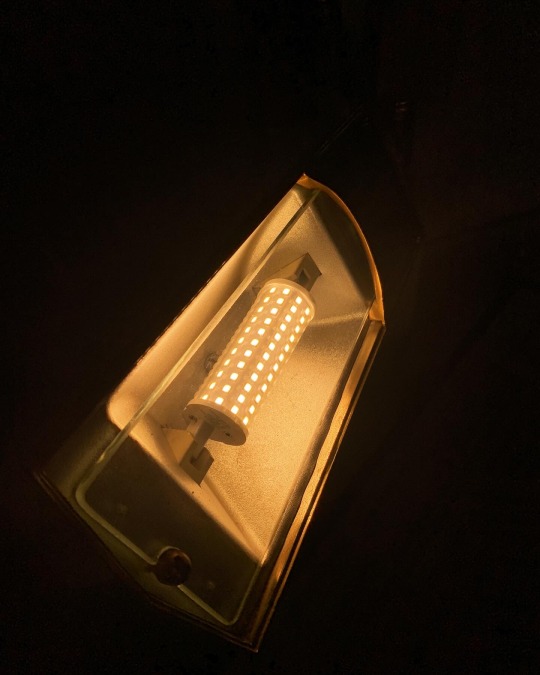






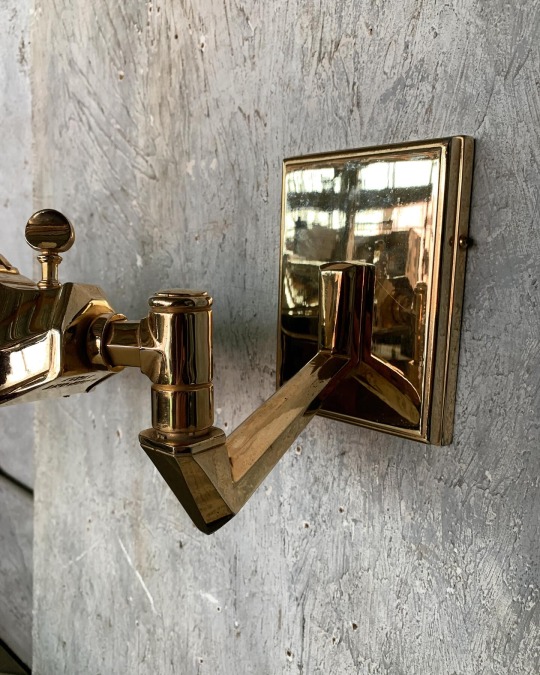
MCM BRASS WALL SCONCE
A stunning brass wall sconce by LAMP ART / ITALY. Stunning and chic design ,light swivels and head adjusts in angle . We replaced the old halogen bulb for a new generation LED bulb made to replace the old ones that used to get so hot ! Design and superb quality. A great light to use to highlight your art.
Item No . E5761
Dimensions. Extends 19" out . Wall bracket is 7" x 5"
List Price. $ 650
504.581.3733 / t
#antiques#nola#magazine street#interior decor#interior design#interiors#new orleans antiques#new orleans#collectibles#lighting#italian light#wall sconce#brass light#art lamp#maga zines treet
1 note
·
View note
Text
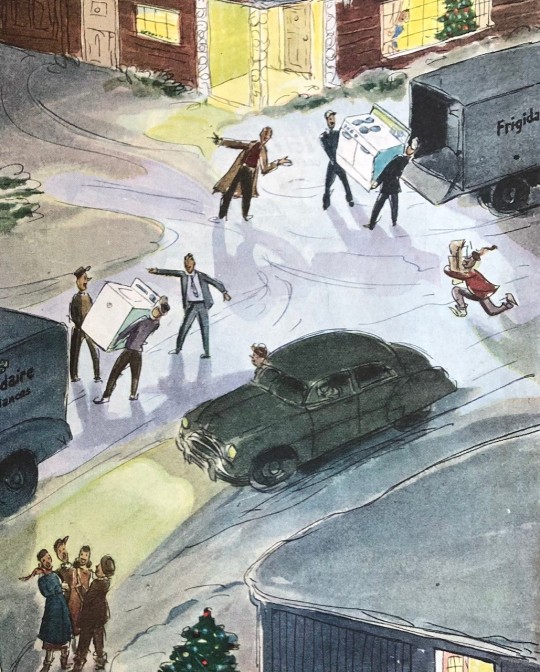
Day 87: “If I hadn’t needed this drink, I would have thrown it at him!”
50s slang of the day: “Just sit back and really tie the feed bag on!” (Just sit back and chow down!)
Best/worst quote of the day: “Love is a state of confusion in which the victim cannot distinguish between spiritual aspiration, carnal desire, and pride of ownership.”
Song of the Day: “Do It Again, Please,” by Wynonie Harris. I smile anytime I think of this guy or hear his music- I’ve developed such an affection for him! I like this song because it’s a bit slower in tempo than a lot of his stuff, but it still swings. Harris’ voice is always amazing, and particularly in this.
Highlights:
My culinary adventures today! I made a recipe for wheat bread that rose well and tasted even better. Then I made a lunch recipe that has been on my “to do” list for weeks- Treet decorated sandwiches. I’ll let the upcoming picture speak for itself!
Jello mold number 13 came out well and is delicious. It looks and tastes just like a dreamcicle.
Seeing the I Love Lucy doll that was advertised in Life magazine on the actual TV show today. I couldn’t believe they really had it on the show.
All the Toulouse-Lautrec art in the movie Moulin Rouge.
Lowlights:
Bawling my eyes out during an episode of Dragnet- an 8-year-old boy was killed by a gun his 9-year-old neighbor was getting for Christmas.
0 notes
Photo
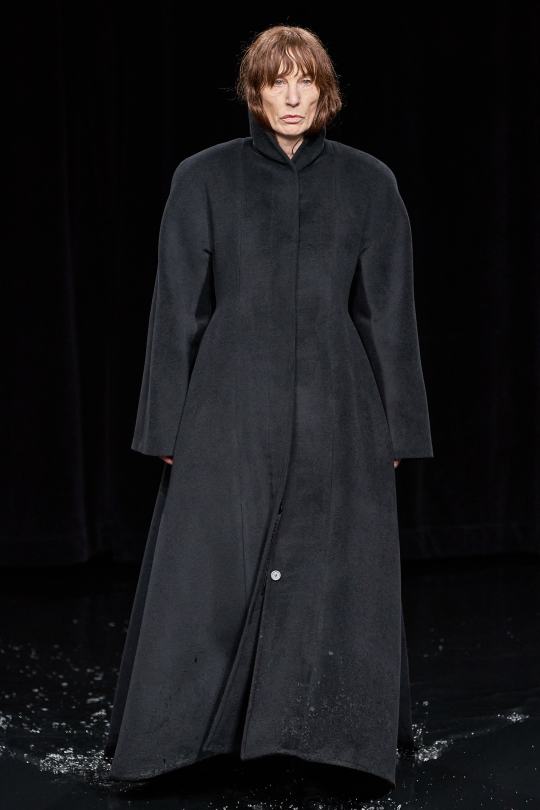
imagine if balenciaga edited collections down to 40 looks, omitted all the $treet wear, fired the DIS magazine art consultant and memory erased the fact Denma is a low IQ individual...it would be incredible (credit where credits due). I love this look
28 notes
·
View notes
Text
Rick Braun:Life in the Fast Lane
BY TOM ERDMANN

Trumpeter, producer, composer, and arranger Rick Braun is an excellent example of a musician who has quietly worked hard for many years and suddenly is recognized as an “overnight success.” His album with saxophonist Boney James, Shake It Up, was number one on the Billboard magazine Contemporary Jazz Album chart for 11 weeks and has moved around in the top five positions for over a year. The first single from that album, Grazin’ In The Grass, hit number one and stayed there for nine weeks, crossed over to the R&B charts, and was named Best Song of the Year at the 2001 Oasis Smooth Jazz Awards. Braun’s awards also include the 2001 Oasis Smooth Jazz Award of or Best Brass Player and Best Collaboration with Boney James.
Born in Allentown, Pennsylvania on July 6, 1955, Braun took up the trumpet in third grade, studied with Philadelphia Orchestra trumpeter Seymour Rosenfeld, graduated from Dieruff High School in Allentown, and enrolled at he Eastman School of Music. While at Eastman, he was a founding member of the fusion group called Auracle. Their distinctive style was quickly imitated by a number of jazz groups and their recordings became mainstays on jazz radiostations through out the northeast. Braun’s first song to hit the Billboard Top 20 was Here With Me, written for the rock band REO Speedwagon. As a trumpet sideman, Braun has worked and toured with an incredible list of musicians including Tina Turner , Rod Stewart, Glenn Frey, Natalie Cole, Rickie Lee Jones, and War.

Braun released his first solo album in 1992. It was, however, his time with Sade on her Love Deluxe tour that helped him focus on a unique style. Braun’s second recording, Night Walk, has been likened to “listening to Sade instrumentally.” Braun’s big break came on the heel s of his third recording, Beat Street, which spent 13 weeks as the number one contemporary jazz album in Billboard magazine, breaking a record previously held by K enny G . Beat S treet was eventually named the Smooth Jazz Record of the Year. It also won the G avin Artist of the Year and Album of the Year awards in 1996. Braun’s next release, Body and Soul, earned him another Gavin Artist of the Year award. His latest release, Kisses in the Rain, has also hit number one on the Billboard chart.
Braun has never been busier or happier than he is right now. Offered more playing and producing opportunities than he can possibly accept, he is also in demand as a jazz musician performing in clubs throughout the Los Angeles area. Braun is truly enjoying his time in the fast lane and doesn’t show any signs of slowing down.
TE: Why did you choose to play the trumpet?
RB: One of my older brothers played the trumpet and because of that there was a trumpet in a closet at home when I was eight years old. As a kid I was into everything, including the closet. I found the trumpet, put the mouthpiece in, and found that I could get a sound out of it. I think everybody who has ever played the trumpet knows that some people can get a sound out of the instrument, and some people can’t. It’ s not an instrument like the guitar where you just put your hand over the strings and a sound comes out. My first choice had been drums, but I grew up in a small row home in Allentown and I’m one of six kids, so as you can imagine, I was gently steered away from the drums. What my parents didn’t know was that the trumpet was the next most annoying instrument for a beginner to play. I didn’t give up much in the way of offense (laughing); I was still able to annoy my siblings!
TE: Did you come from a musical family?
RB: My mother, who is 84 now, is still very musical and has a good ear. She’s a self taught banjo player.
She played a four-string banjo, the really old kind, and learned piano by herself. On her side of the family my grandfather was a country fiddle player, my grandmother played the piano, and one of my uncles played the cornet. All of the musical talent was on my mother’s side. When my dad tried to sing to us kids at night we would pretend we were asleep so we wouldn’t have to listen to him. The only song he knew was the Notre Dame Fight Song, and he didn’t even like Notre Dame!
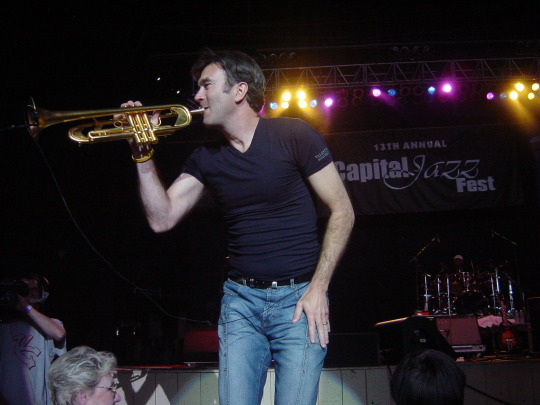
TE: I have read that you studied with Seymour Rosenfeld. I had the pleasure of interviewing him and was impressed by what a nice man he is.
RB: You know, he really is.
TE: When did you study with him and how was he able to help you?
RB: I started studying with him my junior or senior year in high school, during the early 1970s. We got into some of the mor e advanced trumpet studies, like thematerial from the Saint-Jacome Trumpet Method and other materials of that nature. He was also the first teacher to introduce me to orchestral excerpts. He wanted me to audition for the Curtis Institute and was really preparing me for that, but I didn’t get in. That year they took only one trumpeter from about 100 who auditioned. As it was I ended up at Eastman, where I really wanted to study jazz.
TE: Were there any other early teachers who inspired you?
RB: My first trumpet teacher, Richard Hinkoe, was great. He is still active as a director of one of the Allentown concert bands. My brother told Hinkoe about me and he agreed to teach me. Hinkoe brought me along especially in music theory. His high school theory courses covered collegiate-level material. When I arrived at Eastman I was put in with the advanced placement theory students and didn’t learn anything new . Hinkoe’s theory course included solfege, sight-singing, counterpoint, four -part harmonic writing, the rules of contrary motion and correct resolution, dominants, altered sixth-chords, and more! He was an amazing teacher!
TE: Allen Vizzutti has told me what an incredible experience Eastman was for him. What was Eastman like for you?
RB: Allen and I played together i n some of the bands at Eastman. He can play anything! I was at a concert where he played one of the Verne Reynolds etudes as a solo. He is just an amazing player. Eastman, on the other hand, was very tense. It was a nerve-wracking experience.
There was one student who developed a nervous habit of pulling out his own hair. I remember during winter midterms one year someone starting lighting couches on fire. That was one side of it. On the other side, it was an outstanding educational experience that was just not for the faint-hearted. It was a highly competitive atmosphere. I had a friend who would get up at 5 a.m. and practice out on the lawn to try to get an edge on everybody else. In many ways Eastman was a humbling experience for me. While in high school, I thought I was the hottest thing around, so I needed to be humbled! The major thing Eastman gave me was exposure to music I’d never heard before, like the music of Clifford Brown, Miles Davis, and Freddie Hubbard. I really started to listen to their playing. I worked to understand the way they played blues changes and how their styles were put together. The education I received at Eastman was exceptional.

TE: Did you graduate?
RB: No I didn’t. I finished my junior year and later took some extra classes at UCLA, but some of the guys in Auracle (Steve Raybine, percussion; Ron Wagner, drums; Bill Staebell, bass; John Serry Jr., piano) were one year older than me, had graduated, and were itching to do something. We planned our next step and realized California was the place we ought to be, so we headed west. Steve Kujala (Auracle’s woodwind player) and I left Eastman one year early, much to the chagrin of our families. It all worked out in the end.
TE: What happened once you arrived in California?
RB: We landed in a band house in the San Fernando Valley. Steve Kujala, Bill Staebell, Ron Wagner, and I all lived together. John Serry and Steve Raybine lived in another house. We struggled, made two records, and played the Montreux Jazz Festival, which w as a big deal. It was fun, we were all good friends, and got a little taste of what it was like to be recording artists at a very early age. Then the whole situation blew up. Our label, Chrysalis, broke up the band after our first recording by signing John Serry to a solo deal. He made a couple of records that didn’t sell well while the rest of us went ahead and made our second record. None of us was really up to the task of filling Serry’s shoes at that point, and it did not go well. It’s the classic story of a record label taking one guy out of a band and destroying the chemistry.
TE: After the band broke up and you found yourself living in California, what happened?
RB: That was probably the darkest time of career. I was not yet established as a trumpet player.
I had some early experiences at session work, but for whatever reason, at that early age, I wasn't able to break into the TV, movie, or commercial scene. I ended up doing odd jobs outside of the music business in order to make enough money to live. I remember being so broke that I wrote a bad check in order to buy food, but ended up taking the food back because I just could not go through with it. I would look at the phone wondering if it was off the hook because nobody was calling. Then, slowly, things picked up. I started to get some gigs playing with Latin bands in East Los Angeles and that developed into steady work. Then I got into playing with rhythm and blues bands and out of that work started touring with War. I also played a lot of bars and weddings, whatever I could find, and joined Jack Mack and the Heart Attacks. They were an R&B band that was very popular on the west coast. As a result of being in that horn section I began working with Glenn Frye and some other well-connected musicians including the guys in Tower of Power. I actually played in their horn section on a Tom Petty record (I played piccolo trumpet on that recording). At some point during that time I hooked up with some of the ended up receiving a call to join that band. I had been struggling, and all of a sudden I’m touring the country with Rod Stew art in a private plane, staying at Four Seasons hotels, and making more money than I ever had in my life. It was both a blessing and a curse. The blessing was that I was better off financially than I had ever been; the curse was that I started to get into drugs and began to drink a lot. On the road there are plenty of ways to get into trouble as far as substance abuse is concerned. The good new s is that I bottomed out and sobered up, and that became a major turning point in my life.
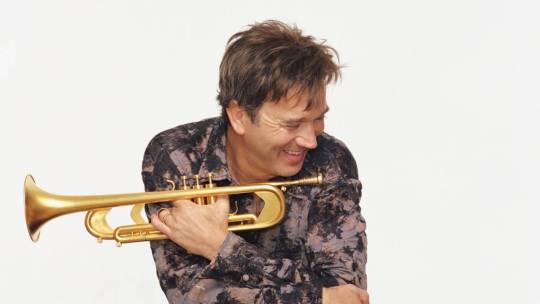
TE: Wasn’t it a kick to play for so many people nigh after night?
RB: It was amazing. I think the most people I ever played for was during a show I did with War in Chicago when the first African-American mayor of that city was elected. The city held a huge concert in Lincoln Park with several hundred thousand people. People were as far back as you could see. The columns of speakers went on forever. I’ve been fortunate; I’ve played for quite a few people in my life.
TE: How did your association with REO Speedwagon come about?
RB: When I wasn’t on the road with Rod, I come back to L.A. and look for gigs. As part of the Jack Mack horn section I played on a n album with REO Speedwagon. The lead singer and writer of REO, Kevin Cronin, and I became friends. Kevin and I had been playing clubs together in a band we had put together with some of the REO Speedwagon guys and some other people. We were both going through hard times over women so I wrote a song about my experience. I had composed it like the Beatles song Yesterday, just a series of verses. Kevin heard it and liked it, and was able to come up with a chorus that really fit the tune. He played it for the guys in the band and they loved it. REO Speedwagon recorded it and it went into the top 20.
TE: Can you tell me how your first solo record came about?
RB:I happened to be in Canada on the road with Rod Stewart and through Steve Kujala I had been introduced to Frank Davies, who is a publisher in Toronto, Canada. I met with Frank one afternoon and played him some of my songs. I invited him to come to the show that night, and it turned out he had worked for Rod way back on his first single. It’s a small world! When Frank heard my instrumental material he said he thought he could get me a deal. He took it from Toronto to Burbank, just 30 miles from where I was living, and got me an independent deal with Mesa/Bluemoon. On Intimate Secrets, my first record, I included a song called Theme from t he Midnight Caller. That song got some significant airplay. My next compact disc was Night walk, followed by Beat Street. During this time I went back on the road with Rod. We were in Europe when my manager called and said that, in America, Beat Street was getting a lot of attention and doing so well that I was going to have to make a decision. I was either going to have to continue to be a highly-paid sideman or give my notice and take the solo gigs that didn’t pay a lot of money but would help me build a career as a leader. I took all of two seconds to think that over. I gave Rod my notice and jumped on a plane back to the States. I was willing to take the risk.
TE: That had to be an exciting time.
RB: It was really exciting. When I first came out with Intimate Secrets, the promotion guy at Mesa/Bluemoon was trying to get some airplay for the recording. He told me that many stations would not play it because it featured a trumpet lead. At that time the only horn players getting airtime were saxophone players. I finally broke through when Beat Street was released and won Artist and CD of the Year Awards at the Gavin Convention (Gavin covers the American radio industry, collecting and compiling the playlists of more than 1, 300 radio stations). Beat Street broke Kenny G’s record for most consecutive weeks as the number one contemporary jazz record and helped set me up as a solo artist.
TE: You have stated that work you did with Sade was important to your musical development. Can you elaborate?
RB: The Sade tour was important because she helped me establish a style. Sade's whole show is about sensuality. I've never been a b listening lead trumpet player, and that tour gave me direction and helped me solidify the idea that I don't have to be an Arturo Sandoval type of player in order to get my message across. Sade is a minimalist on stage. From that, I realized that what I have to offer as a musician is valid, and as long as I believe in it and I'm committed to it, I can create a musical fingerprint.
TE: (Jazz saxophonist) Joe Lovano once told me that the great ar tists have a sound that is recognizable in the first three notes. I remember he and I were laughing about the truth to tha t statement and he said,“Three notes, boom, John Coltrane; three notes, boom, Eric Dolphy.”
RB: That is it exactly. Look at Miles.

TE: I read a critic who said that you are the man who reintroduced the trumpet to the contemporary jazz scene. For the longest time, the only music that was getting played by horn players was by saxophonists. How does it feel to have had that kind of an effect on the music scene?
RB: It feels good that I've got a house I can pay for by doing the thing I love to do. That is the ultimate gift—doing what I want to do for a living. I am amazingly fortunate. I think part of the reason I've been so blessed has to do with timing. When I came out with Beat Street, there was a need for another voice. At that time there were only saxophonists like Grover (Washington Jr.), David Sanborn, and Kirk Whalum; George Benson on guitar; and David Benoit and Joe Sample on keyboards. After Chuck Mangione stopped getting airplay, the only other candidate was Herb Alpert, and he had stopped making records with any degree of frequency. There was a window of opportunity and I was fortunate to be in a position to make records. Another thing that happened with Beat Street is that people started coming up to me and saying, "Man, I knew that hip-hop beat was going to catch on." Interestingly enough, the production on that album was minimal at a time w hen bands like The Rippingtons and SpyroGyra were doing complicated material. Beat Street by comparison is really very sparse.
TE: I have to admit I hate the term “smooth jazz,” but there are a number of traditional jazz musicians who have been putting out albums under that title; saxophonist Kenny Garrett and keyboardist Rachel Z come to mind. It seems that many jazz artists are going in this direction. I have found that with the best players there is no snobbery in music anymore.
RB: Well, I wish that were true for everyone. We cannot get a decent hearing from any of the reviewers in Los Angeles. The L.A. Times has the door totally shut. The reviewers won't even stay for the shows. I had a conversation with one of them who just started slamming the music. I was convinced he hadn't even listened to my record, which turned out to be true. I told him that maybe he should listen to it before being critical. He did go home and listen to my compact disc, and called me back to say that he enjoyed it.
TE: I've let a number of my collegiate jazz students borrow some of your recordings. The other day one of them came by and mentioned how he was surprised and delighted that you find ways to go past stereotypical smooth jazz, both harmonically and melodically.
RB: Last week I played a straight-ahead gig with Gerald Albright on saxophone, Harvey Mason on drums, Dave Garfield on keyboards, and Kenny Wild on bass. We played at the Baked Potato, which is just a little club here in California. We didn't tell anyone we were going to do it, but as often happens, word spread. For me, it is just so much fun to play straight-ahead. And when I practice, I practice that way. I practice scales, flexibility, etc. For me, the way I'm going to improve as a player is by learning how to play changes better. No matter what you have laid out as a solo, you still have to navigate the changes. It probably sounds simplistic to even mention it in that way, but that's the way it is. It's a lifelong challenge!
TE: Many musicians say it’s the struggle that seems to keep them going. They’re always looking for the next mountain to scale, pardon the pun, or the next musical peak to climb.
RB: Yes, exactly. Along with that thought, I always found myself thinking that the moment I ’m really pleased with something I ’ve played, I immediately find something else I didn’t like. It’s really about taking a Zen approach to the music. For me, when I practice, it’s about refining the craft, improving my technique, and increasing the number of too ls available to me. I’m always working to increase the number of scales, patterns, and other musical materials which I have available. When I perform I want to approach the music with the Zen concept of not thinking ahead or behind, just being in the moment. That’s when I think I’m doing my best work.
TE: Do you still find the time to practice?
RB: Yes, I really do. I don’t practice as much as I would like to. When I ’m producing, I need to spend a great deal of time with the artist. When working with other artists, there are a number of other things that go into the pr oduction, and those things take away from the time I want to spend practicing. When I’m traveling, I’ll have to spend the whole day on the road, and when I finally arrive in the hotel it’ll be time to sleep. I’ll have to go into a big show without practicing the previous day.
TE: Are there things you like to practice on a daily basis?
RB: What I’ll try to do now is find patterns of five or six notes that I really like and then explore them, fully develop them, interpolate them, and run them in all key areas. I’m trying to build my musical vocabulary. I also like to play the piano. Having an instrument that allows me to think of harmonies in a non-horizontal way helps to visualize what’s going on underneath the melody. Another thing, and I’m not ashamed to say this, is that part of my practice is done to the Jamey Aebersold recordings. For the most part, when the music is recorded with a live band, as opposed to when it sounds like it was sequenced, it is absolutely great. I have a studio here at home, and I’ll transfer a track like Joy Spring onto my hard disk, set up a microphone, and lay down several tracks. Then I’ll go back and listen critically. I try to under stand where my problems are and then work to improve my weaknesses.
TE: What advice do you have for young musicians?
RB: Here’s what I did that was a mistake. When I was at Eastman, I used to go to the practice rooms in the basement where everybody would walk by and hear you. I’m a natural ham. I always wanted to sound good and to impress people, so I would play the first couple of bars of Brandenburg No. 2. I couldn’t get through the whole thing to save my life, but I had the first entrance nailed! I think kids need to know that you have to practice what sounds bad. Play the material that sounds the worst, and practice it the most. Of course you want to play stuff you can play well, and I do too, but instead of always playing in F minor, play in B minor or F-sharp minor. Instead of playing a blues scale, work on the Lydian chromatic concept and Mixolydian scales. One of the things I did when I was learning the trumpet was to take the Clarke Technical Studies and incorporate them into as many different scale forms as possible. Early jazz education is usually restricted to major, minor, and diminished. Rarely do you learn about altered or Dorian scales until you get to a more advanced level. By adapting the Clarke studies i n a variety of ways, you create a big toolbox. If major and minor are the only scales that are second nature, you will be limited. It would be like fixing a car with only a wrench and a screwdriver. You’ll soon find that you need more tools!
Equipment
Mr. Braun plays a Getzen trumpet and flugelhorn from the custom series. His trumpet has a cryogenically treated bell. His mouthpieces are from his own signature series by Marcinciewicz Music Products.
1 note
·
View note
Photo
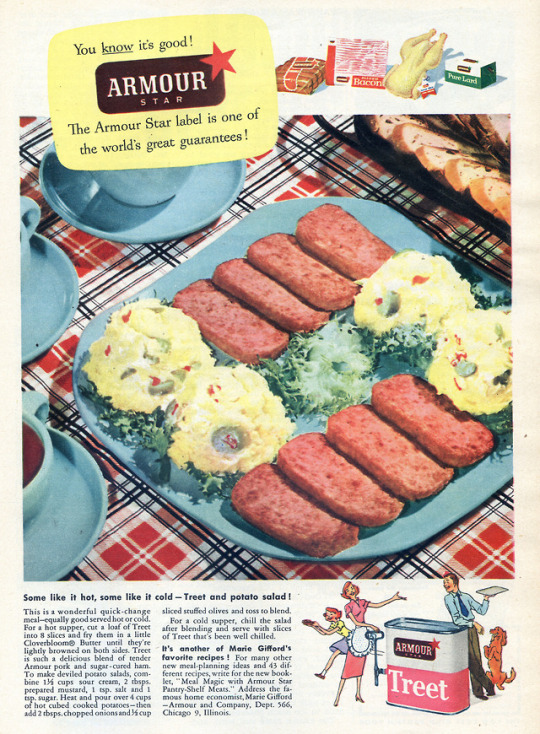
Treet!
Treet!
Treet!
Treet!
Lovely Treet!
Lov-e-ly Treet!
Nope, ain’t going to work. What else do you have?
Better Living Magazine July 1952
3 notes
·
View notes
Photo
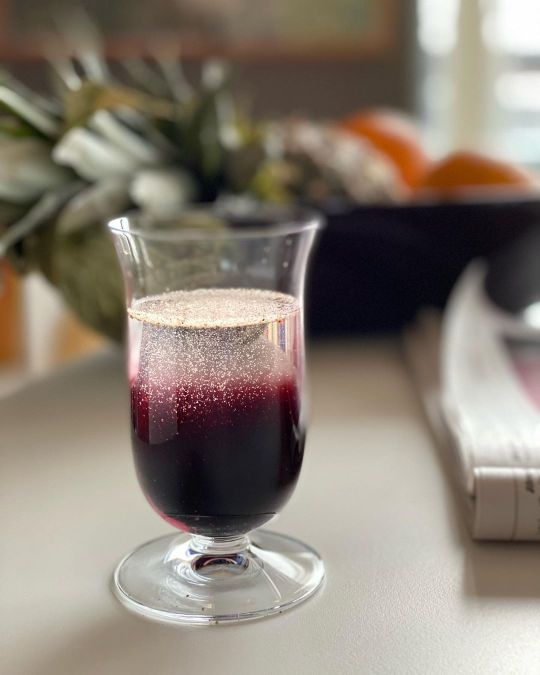
Gin Sangaree, ur-cocktail og fabulously old style, med røtter tilbake til 1700-tallet. I trykksvertlig form dukket en variant av dette vidunderet for første gang opp i 1736, i The British Gentleman’s Magazine. Gin og portvin er en knallkombinasjon. Storbritannia møter Portugal, den gang to av de mektigste imperiene i verden. Jeg vet ikke om dette hører med til historien til Gin Sangaree, men nå slår drinken inn, her jeg sitter og taster, og jeg føler en sterk trang til å spekulere. Båndene mellom Storbritannia og Portugal var tette. Britenes dronning Catherine of Braganza (1638-1705), som giftet seg med Charles II, var fra Portugal. Catarina fra huset Bragança. Det var hun som introduserte te som en britisk hoff-øvelse, og vanen med å innta den klokka fem om ettermiddagen (five o’clock tea). Kanskje vanket det med teen også portvin (akkurat som afternoon tea i dag egentlig handler om champagnen, det er jo den vi gleder oss til)? Og kanskje kleiste hun til med litt erkebritisk gin, hvis hun trengte kraftigere egenmedisinering? Stakkars Catarina var en hardt prøvet innvandrer. Hun ble beskyldt for å ha planlagt å forgifte kongen og for høyforræderi. Hun produserte heller ingen arving. Katolikk var hun også. Make me a Gin Sangaree, por favor! Sangaree er en gammel måte å si sangria på. Det portugisiske ordet for blod er sangue. Det er portvinen som er «blodet» her (slik rødvinen er det i sangriaen som er mest kjent i dag). To deler gin, en halv del sukkerlake (aka simple syrup) og én del portvin. Rør (ikke shake) gin og sukkerlake sammen med litt is. Hell over i glasset uten å få med isen. Hell deretter over portvin. Portvinen synker til bunns slik at det øverste laget blir klart. Topp med nyraspet muskatnøtt. Et dryss felles kolonihistorie på toppen, altså. Muskatnøtt-treet kommer fra øygruppa Molukkene (også kalt Krydderøyene) i Indonesia, som europeerne for første gang kom til da portugiseren Vasco da Gama (1469-1524) fant sjøveien til India. Både britene og portugiserne hadde interesser på Molukkene. Mange typer glass brukes, men i Casa Børgita et høyt Single Malt-whiskyglass fra Riedel. 🙏🏻 #ginsangaree #cocktail #port #gin #riedel (ved Grünerløkka) https://www.instagram.com/p/CMXWDLCgqSi/?igshid=t4h3fowi1bce
0 notes
Photo
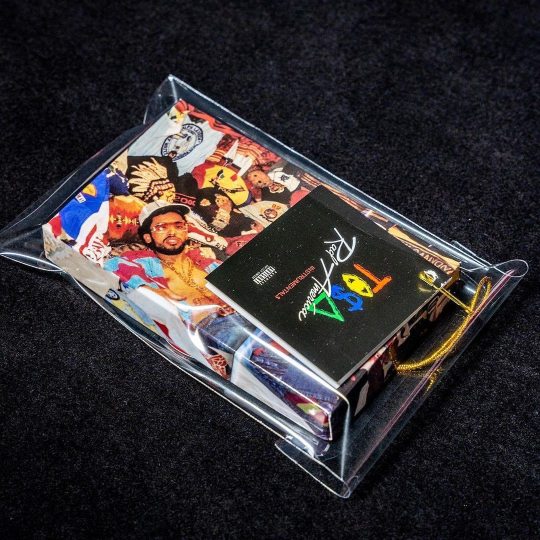
Posted @withregram • @strictlycassette RAD AMERICA IN$TRUMENTALS by Taz Arnold ™️✨ Photos & Article: TRACE Magazine circa 2006 (No longer in print or published online.) Article features the West & East Coast Polo Kings: Taz Arnold & Thirstin Howl III. Taz Arnold’s Rad America is an Experimental Black Los Angeles Dance Party on acid. Originally Released in 2012 and still to this day sounds like something from the future. Now for the first time we will be able to experience the instrumentals alone. With vocal samples and music layered on top and between each other in such unique patterns like a maniac wizard whipping together new potions. Taz the founding member of the group SA-RA, has worked with and influenced many of the artists of today in music & fashion from Kendrick Lamar to Virgil Abloh and Kanye West. A man who has been and is always ahead of the curve. Produced by Taz Arnold Bass Guitar: Thundercat Keyboard: Kenneth Crouch Engineer & Edits: Thayod Ausar Mixed by Taz Arnold, Thayod Ausar Recorded at TI$A $treet $tudios Mastering: Bernie Grundman INSTALLATION by Strictly Cassette® #TI$A Available Now! Link in the Bio! (at New York, New York) https://www.instagram.com/p/CJMeOZXlAEc/?igshid=dx4dbn1p5dgm
0 notes
Note
I’m really curious about your translating process. At first I thought you did it alone, but as I scrolled through your page, it’s obvious you have a team. So how does everything work exactly? How many people are in the team? What does BSI stand for?
Beika Street Irregulars
So at first our proofreader Nay-chan buys the electronic version of the magazine, our cleaner Serinox cleans while I translate the pages.
After that Neuro, the typesetter/English proofreader proofreads the text, I post it on tumblr, then the real pain in the ass begins, the typesetting, in which we have to reorganize the words in already translated sentences so that they will fit in bubbles perfectly.
Meanwhile, redrawer, Tea, redraws the cover of the chapter (after deleting Japanese chapter text), to make it ready for the release
And after that out proofreader Nay-chan (Japanese proofreader) looks through the alpha version of the scanlated file, sees typos and mistakes, which we fix
After that we upload it on batoto...
And then we realize that we missed a typoTake down the batoto releaseChange psd, save as png, overwrite, upload againOnly to realize it was the wrong archiveAnd we reupload it againWhile keeping the straight faceBut crying and laughing at the same timeAnd then we sleepFOR A LOOOOONG TIME
37 notes
·
View notes
Photo
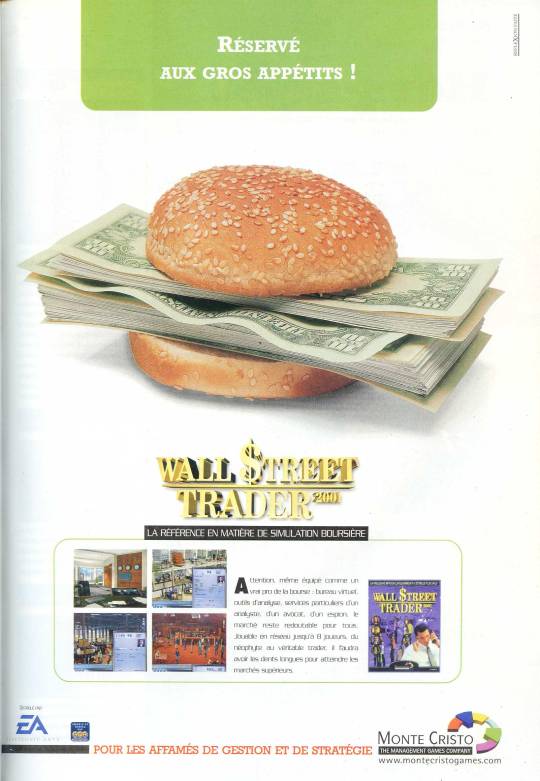
‘Wall $treet Trader 2001 - “Reserved for Big Appetites!”′
[PC] [FRANCE] [MAGAZINE] [2000]
Génération 4, December 2000 (#140)
via Abandonware Magazines
#gaming#advertising#wall street#wall street trader 2001#management#simulation#france#electronic arts#monte cristo#pc#computer games#2000
10 notes
·
View notes
Text
The Comprehensive structure of Global Double Edges Blade Market 2025 and topmost key players: Edgewell, Gillette, BIC, etc.

"Global Double Edges Blade Market research Report analyzes worldwide players of the market by studying various segments and end-user applications. Individual analysis of top regions and countries like North America, Europe, Asia-Pacific, South America, Asia-Pacific, Middle East & Africa and Latin America and the rest of the world is conducted. Industry overview, product definitions, and growth status are presented. The present Double Edges Blade statistics and future trends are analyzed for a period of 2019-2025.
The key attributes of interest of Double Edges Blade report include gross margin study, price, trends, production, revenue analysis, and import-export details. The opportunities, growth and market risks are analyzed at depth in this report. The technological advancements, geographical zones, product categories, and applications are presented. The end-users of Double Edges Blade, traders, distributors, dealers of this industry are analyzed at a global scale.
Global Double Edges Blade Market statistics and figures are represented in a concise manner in the form of tables, pie charts, reference diagrams. The top industry players with their market share, development prospects, growth graph, and production rate in Double Edges Blade are analyzed.
Get Free Sample PDF Copy Of Global Double Edges Blade Market Research Report: click here for more info
Top Leading Manufactures Studied in Global Double Edges Blade Market: Edgewell, Gillette, BIC, Supermax, Lord, Malhotra, Benxi Jincheng, SRBIL, Treet, Feather, Feintechnik, AccuTec Blades, Kaili Razor, Shanghai Cloud, Yingjili
The report identifies major attributes of Double Edges Blade industry like new product releases, mergers & acquisitions, joint ventures, on-going development and services. Also, insights into regulatory restrictions, futuristic applications and recent technological advancements are explained.
Market segmentation
Global Double Edges Blade Market Segmented By Type: Carbon Steel Blade, Stainless Steel Blade
Global Double Edges Blade Market Segmented By Application: Razor blade, Industrial blade
Inquire Here For Queries Or Report Customization: click here
Double Edges Blade Market
Research Goals:
• Our onboard research team experts and industry analysts present a precise and comprehensive study to offer Double Edges Blade industry outcomes. Key players analysis is supported by primary and secondary study.
• With the help of our analysis, competitors can identify Double Edges Blade industry potential, opportunities, and market risks.
• The product contributions, revenue segmentation, business strategies, and other sub-segments of Double Edges Blade are micro-monitored.
• The report is analyzed on two base factors namely market size (k MT) and market revenue (USD Million). The growth and market trends are studied at each level.
• Overall market strategy, capacity analysis, sales channel analysis, and supply chain value of Double Edges Blade is covered.
• Manufacturing process analysis, cost structures, raw materials study, upstream and downstream suppliers study is explained.
• Product classification, R&D status, traders, distributors, suppliers are comprehensively analyzed.
• Each product type, applications, geographical regions, and market trends are presented at depth.
Reasons to invest in this study:
• Market growth drivers and influencing factors of Double Edges Blade are explained. Geographical regions showing high CAGR are analyzed.
• Double Edges Blade industry analysis at a global and regional level with insights on key players, competitive landscape and market share.
• Market division based on product type, application and geographies are studied.
• Emerging sectors of Double Edges Blade, forecast growth statistics, emerging regions are thoroughly evaluated.
• Gross margin study of Double Edges Blade Market, industrial norms, import-export analysis, and government regulations are stated.
• Changing Double Edges Blade market competition, complete industry insights will lead to the informed decision-making process.
Our report will address client queries:
1. What is the market share of each region and top countries present in these regions?
2. Which countries will depict the highest growth potential in the coming years?
3. At which rate the Double Edges Blade market is growing globally and what are the future trends of this industry?
4. Which are top product type and applications holding good potential and growth opportunities?
5. Which are top Double Edges Blade industry players and who is their market competitors?
6. Which are market drivers and constraints at present and during the forecast period?
7. Which are the traders, dealers, and distributors operating in Double Edges Blade Industry?
The research is based on varied secondary and primary data sources. The primary sources include access company’s annual reports, product literature, government releases, industry magazines, paid sources and government magazines. Gathered data is verified by conducting paid primary interviews with industry experts.
Thanks for reading this study; you can also request customized content for instance chapter wise section or region wise report content.
Browse Detailed Table Of Content @: click here for more
0 notes
Photo



NEW ORLEANS JAZZ FATHERS II
Offered here is a real gem of New Orleans and Jazz history. An original Ticket for a Mardi Gras dance given by the Orleans Stock Club for March 19th, 1918.
There are so many historical details coming together in this card. I’ll try to highlight a few .
The date, St. Joseph Night, March 19th , 1918. / A few months before the end of the WWI . St Joseph’s Night in New Orleans has a special meaning , a night where the Wild Indians of Mardi Gras celebrate out in the streets. not sure how old this ceremony is but that this dance card date is for the same night looks like no coincidence to me . If you want to learn more about the Wild Indians and St Joseph” nigh I recommend this article .
The Venue, ECONOMY HALL , a dance hall where trombonist Kid Ory’s Creole band cultivated jazz improvisation as far back as 1910. Economy Hall was not only a legendary laboratory for jazz improvisation, as was typical of the many social aid and pleasure clubs at that time. It also provided a variety of social services, including brass band funerals and dances, to the New Orleans black community. A new book ( Fatima Shaik’s Economy Hall: The Hidden History of a Free Black Brotherhood ) sheds light on the less know side of the Hall , a remarkable history that preceded jazz by almost a century. The radical politics and philanthropic efforts of the society that built Economy Hall touched most corners of New Orleans and some parts of the globe. From a modest house purchased secretly by the members of the Société d’Economie et d’Assistance Mutuelle in 1836 to the famous Economy Hall that stood until 1965, a diverse cross-section of people came to Ursuline Street to socialize, debate, advocate, dance, memorialize the dead, and bring back some of their dearly departed in seances. Communal, political, and soulful—in sum, Economy Hall was New Orleans under a roof. The fifteen free men of color who began the organization and the others who joined during the society’s early years reads like a roster of well-established Creoles of the 19th century: Pierre Crocker, builder and lover of Marie Laveau; Etienne Cordeviolle and François Lacroix, international tailors whose designs and real estate holdings made them wealthy; Pierre Casanave, a well-known mortician; Charles Martinez, musician, grocer, and later notary; and Ludger Boguille, a teacher beginning in the 1840s and important secretary of the organization.
The Band, The Magnolia Orchestra , no other than Louis Keppard’s band. Now if you are something of a Jazz aficionado or nerd , you might have heard the name. Louis Keppard was not only Freddie Keppard’s (successor of Buddy Bolden as “ King” ) older brother but an accomplished Jazz Guitarist and band leader . He led the Magnolia Orchestra, which became the regular band at Huntz's and Nagel's cabaret on Iberville in the District. The Magnolia Orchestra included Joe Oliver on cornet, who would later succeed Keppard's title as "King" by winning a "cutting contest" against him.
Louis Keppard, Afro-French Creole guitarist, alto horn player, and sousaphonist Louis Keppard (1889-1986) was the older brother of cornetist Freddie Keppard. He took guitar lessons from Bud Scott and Willie Santiago. Before 1915 he was the leader of the Magnolia Band, which often worked at Economy Hall in Tremé, but also played with Oscar Celestin and Manuel Perez, as well as performing with the Olympia Band led by his brother. After a brief sojourn playing vaudeville theaters in Chicago in 1917, he returned to New Orleans, playing alto horn with brass bands. In the 1940s Keppard worked as a solo guitarist and with Wooden Joe Nicholas in dance bands and in the 1950s and 60s played sousaphone with the E. Gibson Brass Band and others.
Joe “King” Oliver , Mentor to no other than Louis Armstrong and pioneer of what would become known as the Harmon trumpet mute, Joe “King” Oliver was a key figure in the first period of jazz history. His most significant ensemble, King Oliver’s Creole Jazz Band, was a live sensation and also the first black New Orleans ensemble to gain recognition in the record industry.
A one in a lifetime chance to own a significant piece of American Jazz and Nerw Orleans history.
Item No. E4984-66.
Dimensions: 2.5″ x 4″
Contact us for more information
504.581.3733 / t
#antiques#jazz#new orleans jazz#joe king oliver#louis keppard#magnolia jazz band#louis armstorng#buddy bolden#historical new orleans#jazz history#old new orleans#new orleans creole#creole#economy hall#mardi gras#st joseph's night#nola#new orleans#ephemera#magazines treet
24 notes
·
View notes
Text

Life magazine, July 28, 1952. Oh my god- dare I try making this? It's so insane I gotta say, I feel tempted. Do they even make Armour Treet anymore? I assume it's like Spam? (OK, I just looked it up! They still make it, and I can even get it on Amazon...)
0 notes
Video
Armor’s Treet by Dave Fey
LIFE Magazine, June 29, 1942.
6 notes
·
View notes
Text
Golden Goose Tenis Galerias seguem Não estão Localizados Ova Dourado
Eles não conseguiram permitir-lhes adaptar-se positivamente a sua nova maneira que as perspectivas tendem a levar o mercado de casa. Basta incluir esses compradores corporativos razoáveis não estão utilizando seu software antes de eu dizer os melhores clientes potenciais. Eles não estão comercializando. Além disso, você também pode ser realmente sincero no seu todo e não é capaz de gerenciar de modo que você desembolsar apenas cerca de dez centavos ao longo da centralização da promoção. Eles estão tão ocupados em beliscar tostões, embora possa ser.
Uma vez que você perceba a singularidade de uma pessoa, o verdadeiro significado por trás de cada um desses nomes sobre sua Golden Goose Outlet Online ista de transmissão, problema. do #, você se torna o caminho para o sucesso quando se trata de construir uma grande casa valiosa para o seu negócio.
Com uma perseverança pouco adequada e resistência sexual, em muitos casos, pode fazer uma boa quantidade de modificar através do Marketing de afiliados. Por ter um jovem saber que você tem a capacidade de estar ganhando vantagem no campo de partida de vendas da filial na hora nope. Basta ter cada pequeno tempo de trabalho para procurar um novo curso, exatamente o que agrada aqueles que gostam, os compradores geralmente estarão mais preparados para gastar o esforço promovendo o programa citado. Normalmente, existem essencialmente milhares, incluindo programas lá para capturar qualquer olho do comprador. No caso de você chegar ao tipo de hobbies e Tenis Golden Goose Superstar nteresses que você mais gosta, alguém terá todo o meu entusiasmo para paixão, a fim de realmente dar-lhes um tempo extra para expandir seu pacote de compra.
'The Wow com a maior parte do trailer / filme de abertura do Twisted Lip' focaliza o Mito do Ópio, diretamente as tocas de ópio em The United Kingdom. Os hiperlinks de mensagens de texto para mais informações, para o exercício 'laudanum' e 'hansom' (Wikipédia), textos relacionados (Confissões de um comedor de ópio e Thomas DeQuincy). Os 2-3 minutos de 'Sherlock Holmes Experience', vídeo que opera cada seção, leva muitas vezes o leitor a assisti-lo na Sherlock Holmes Gallery e na Chef Golden Goose Tenis treet, com narração de arquivistas e jornalistas especializados em tudo e blogs. Os tópicos incorporam a descoberta de restos de todos os Sherlock Holmes, da String Magazine, dos poderes de observação de Doyle e de todos os muitos itens associados, enquanto Holmes, como o cachimbo de seu parceiro, e também glaas de ampliação magnética.
Você talvez tenha sido dito a rima de loja de jardinagem quando se trata do Older Egg, além do ganso de ouro on-line. Se isso supusermos que o Ovo de Ouro será um desses públicos-alvo que indubitavelmente lhe valerá muito mais do que sua família obterá agora, ou o que é mais agradável de se obter, ou um em que certamente você poderá receber menos do que um cliente mas, no entanto, como essas empresas são mais rápidas de vender, você as estará vendendo em capacidade, o que definitivamente fará com que a sua empresa tenha muito dinheiro. # # # # Faça sim o programa que você Outlet Online Golden Goose Superstar scolher tem suas principais taxas de juros melhores no coração. Antes de dar a um bom teste de Classe de Afiliado, certifique-se de que eles lhe fornecerão algum tipo de estatística em todo o mundo. Para monitorar seu sucesso, uma página de resultados é projetada para permitir que a maioria das pessoas saiba onde você está avaliando a cortesia do sucesso. Os clientes estão efetivamente trabalhando 24/7 para os nossos afiliados verdes da sua escolha incrível. E eles, em troca, devem cometer isso para que você possa verificar onde as pessoas estão, permitindo que qualquer um use apontar para uma página de estatísticas.
A manhã adjacente, Meu marido e eu precisávamos para deixar a cidade cedo, além disso, sou urgente, o que muitas vezes produzo o carro consertado. Esta é a palavra que eu tenho. do proprietário para fazer com o negócio da estação de assistência. 'Eu tenho a minha roupa de dormir e até mesmo indo para que ele vai dormir'.
0 notes
Text
Aesop Celebrates the 2019 DesignTO Festival With An Installation by Philip Beesley
Suspended from the ceiling inside Aesop‘s Queen Street West is a piece of artwork entitled Aletheia by Toronto-based designer Philip Beesley. It’s there to commemorate DesignTO, Canada’s largest cultural celebration of design, now in its ninth year. Beesley will be in-store later this evening to present his creation, which also recently appeared in “Transforming Space,” a dual exhibition held with fashion designer Iris van Herpen at Toronto’s Royal Ontario Museum this past summer.
Known for its sustainable store designs and plant-based skincare, Aesop has a history of supporting local artists, often calling on designers and architects in the designs of their retail spaces. “It is always a pleasure to showcase likeminded creative spirits within our spaces. We found a natural kinship with Philip Beesley—we recently launched this year’s Gift Kits, ‘Atlas of Attraction,’ a shared effort with mutual collaborator, Iris van Herpen,” said Marsha Meredith, Aesop’s creative director in a press release. The piece mimics the shape of a head’s bone formations outlined by a thin membrane that motions in response to its environment. It also features a spherical meshwork of spines, fronds, and glasswork.
PHOTO COURTESY OF AESOP.
Beesley, who’s a part of the Waterloo Architecture and Living Architecture Systems Group, drew his inspiration for Aletheia from a philosophy of deep interconnectedness. “I love the sense that these interwoven, intermeshed forms might also support a kind of collective consciousness,” says Beesley. “Perhaps the hovering sphere of Aletheia’s form might act as a kind of thinking skin for the earth.”
You can see Beesley’s artwork at Aesop Queen Street West until Jan. 27.
PHOTO COURTESY OF AESOP.
The post Aesop Celebrates the 2019 DesignTO Festival With An Installation by Philip Beesley appeared first on FASHION Magazine.
Aesop Celebrates the 2019 DesignTO Festival With An Installation by Philip Beesley published first on https://borboletabags.tumblr.com/
0 notes
